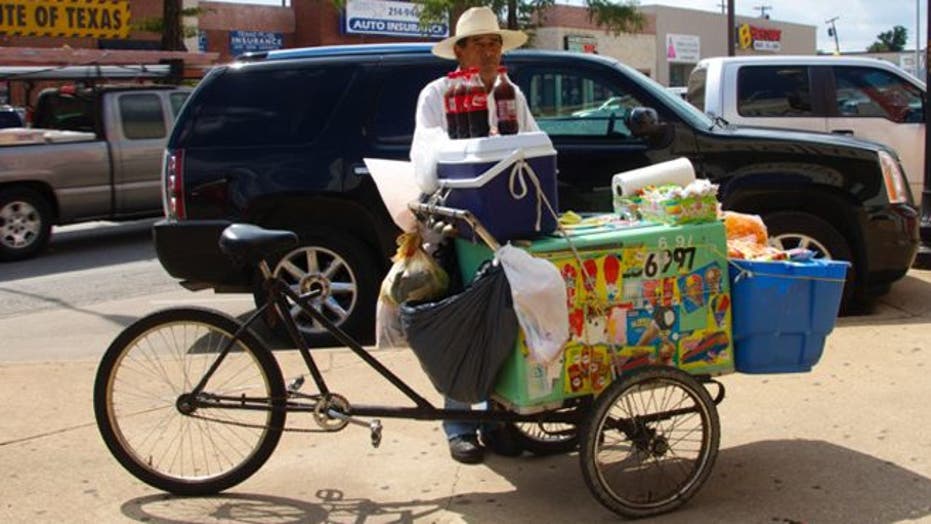Dallas, Texas – Local bicycle vendors pedal through the street selling fried chicharrón and Coca-Cola. Mariachi music pulses above the traffic sounds while kids run around with melting paletas. While this might sound like a scene from a small town in Latin America, it is just everyday life on Jefferson Boulevard in Dallas’ Oak Cliff district.
Situated just south of downtown Dallas and west of the Trinity River, Oak Cliff has been home to one of the largest Latino populations in Dallas since the 1960s. Jefferson Blvd. is known for the Texas Theater, a small movie house that gained notoriety when Lee Harvey Oswald was arrested inside.
The street is also the heart and soul of the Latino community in Oak Cliff.
As much as 76 percent of people in the district is Hispanic, making it one of the largest Latino areas in the city of Dallas (where, in all, Latinos account for 42 percent).
That heritage is on display in the food, art, clothing, music and shops of Oak Cliff, but it wasn’t always this way.
- Best pix of the week
- A Dying Texas Shopping Mall Is Reborn As A Latino Community Center
- Overcrowded Conditions Of Undocumented Immigrants Held By U.S. Border Patrol
- Tony Romo leads Dallas Cowboys on yet another comeback to beat St. Louis Rams
- Tony Romo, Cowboys Dig Too Deep A Hole In First Half, Lose Season Opener To 49ers, 28-17
- Tony Romo, DeMarco Murray lead Cowboys over Saints, 38-17
- A Messi Jersey? Oh, Please! This Texas Barber Can Put Messi Himself On Your Head
Over the years the district attracted the remnants of Little Mexico, as the Uptown area of Dallas was once known, now a curtain of high rises that screens the city from surrounding neighborhoods.
Little Mexico was the birthplace of many Hispanic landmarks like the still-popular El Fenix restaurant, which dates back to 1918, and the Dallas Tortilla and Tamale Factory, established in 1950.
Over the decades, rising property costs and highway development began transforming the area into a business center, pushing the Hispanic population and shops out.
In the 1980s, the Dallas Tortilla and Tamale Factory, which sells homemade tortillas and traditional tamales, was one of the Latino businesses that relocated to Oak Cliff from Little Mexico.
Ruben Leal, the son of the Factory’s founders, told Fox News Latino, “When I first came here in 1984 from North Dallas, there was a good mixture of people. Then it slowly became almost all Hispanic. But in the past 7 to 8 years, I have noticed that the Hispanic population is starting to move out.”
He credits this movement to the 2007 construction of the Margaret Hunt Hill Bridge over the Trinity River, which connects Oak Cliff to downtown Dallas. Since the bridge opened, more and more private investors have bought up property in the neighborhood.
“Business can’t expand north anymore, it’s too packed. So it’s all coming this way,” Leal said. “I think this community will just move even further south again.”
Gerardo Robles, the Cultural Programs Coordinator for the Oak Cliff Cultural Center, has dedicated himself to fostering and growing the Latino community through the free art workshops, events and galleries that he plans for the cultural center.
“I think what we do here brings everyone together,” Robles told FNL. “It builds bridges between the Mexicans, Dominicans, Puerto Ricans and Salvadorans alike. It’s a way for me to give back to the community I was born and raised in, and that’s probably the best part of my job.”
The increase in property values also has brought with it public safety measures that are very welcomed by the Latino residents. Oak Cliff is becoming a safer, more pedestrian-friendly neighborhood.
As a result, non-Hispanic Dallasites are starting to see is as an up-and-coming neighborhood, and the Latino community sees these changes as a potential threat.
“I’m worried about losing the essence of what Jefferson really is,” said Robles. “But “I like the changes that are coming in; I think it’s something that needs to be done.”
Robles is confident, though, that preservation of the Latino culture in Oak Cliff is possible, but it “comes down to leadership.” He called for members of his community to be more politically involved.
“People will need to step up to keep this place what it really is despite the coming changes.”

